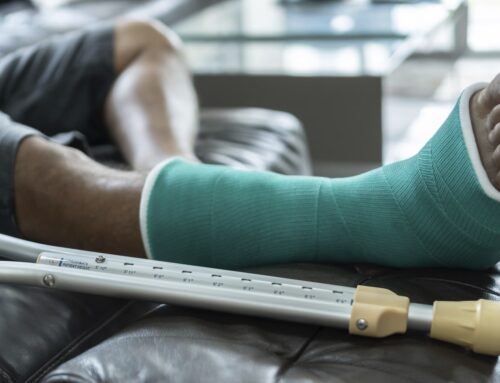Carpal tunnel syndrome (CTS) is a common and treatable hand condition that causes numbness and tingling in hands, pins-and-needles pain, decreased hand strength and worse symptoms at night. It affects 1 in 10 people and is the most expensive upper-body musculoskeletal disorder in the U.S.
Obtaining the right diagnosis for hand numbness and pain is important. Hand pain can result from a variety of conditions. An accurate diagnosis from an orthopedic doctor ensures patients receive the most effective treatments to prevent or slow further damage.
What is carpal tunnel syndrome?
CTS is a medical condition causing numbness, tingling, pain and/or swelling in the thumb, index, middle and side of the ring finger. The condition can also radiate discomfort up the arm toward the elbow or shoulder.
The location of the numbness and tingling in the hands is a major indicator for carpal tunnel syndrome. CTS is caused when pressure inside the carpal tunnel increases, compressing and cutting off circulation to the median nerve in the wrist.
Carpal tunnel syndrome symptoms
Common symptoms of carpal tunnel syndrome include:
- Numbness in hands or hands “falling asleep”
- Tingling or “pins-and-needles” sensations in the hands
- Pain radiating from the wrist up the arm – possibly causing elbow or shoulder pain
- Decreased strength when pinching or gripping with the hand
- Difficulty holding objects, putting on eye makeup or twisting off jar lids
- Numbness in hands while sleeping
- Increased discomfort at night, when driving or holding a telephone
Causes of carpal tunnel syndrome
More than half of CTS cases are idiopathic, which means they have not been attributed to a known cause. Other cases are caused by repetitive motion, risk factors and diseases.
Gender, age, race, obesity, repetitive wrist motions or trauma; rheumatoid arthritis; thyroid disease; and diabetes all can contribute to CTS.
Gender – Women are two to three times more likely to develop CTS. Females tend to develop symptoms around menopause (ages 45 to 55) or during pregnancy.
Age – Carpal tunnel syndrome occurs most often in people over the age of 45.
Race – White or caucasian people are twice as likely to develop CTS.
Obesity – A high body mass index is strongly associated with carpal tunnel syndrome.
Repetitive motions or trauma – Jobs involving highly repetitive wrist movements using vibratory tools and increased hand force have been associated with CTS. This often causes work disabilities and missed time from work.
Rheumatoid arthritis and thyroid disease – Both of these diseases can cause mild to severe thickening of the lining of tendons, narrowing the carpal tunnel and contributing to CTS.
Diabetes – Diabetes often damages nerves and circulation, both of which can contribute to CTS.
To prevent further damage to the median nerve, experts urge patients to seek an early diagnosis and treatment for carpal tunnel syndrome.
How is CTS diagnosed?
If you are experiencing numbness and tingling in your hands, visit an orthopaedic hand specialist, like Dr. Jeremy Miles at Cary Orthopaedics. Orthopedic hand specialists have extensive training and experience treating hand pain and can most accurately diagnose and treat your condition.
History of symptoms
Your hand specialist will ask a series of questions about your condition. Questions may include:
- How long have you had this condition?
- How often do you have feelings of numbness or tingling in your hands?
- How long does the numbness or tingling last?
- Where do you feel the pain, numbness or tingling?
- What makes your symptoms better or worse?
- Have you noticed a decrease in your grip strength?
- Do you notice a difference in your symptoms in the evening?
- Do you have numbness in your hands while sleeping?
- What do you do at work? What are your hobbies?
Carpal tunnel physical exam
After reviewing your symptoms, the orthopaedic hand doctor may perform a physical exam. Checking your hands, arms, shoulders and neck helps to rule out other causes of your symptoms.
The physician will examine your wrist and tap or press on your median nerve to see if it causes a numbing or tingling sensation in your hand. They will also test your grip strength and the feeling in your fingers.
X-rays, ultrasounds and testing with electrical signals
Your doctor may order X-rays to reveal any fractures, arthritis or other diseases. An ultrasound may be used to see if your median nerve is compressed or swollen.
They may also order an electrodiagnostic test to reveal any muscle damage or slowing of nerve responses.
Treatment for carpal tunnel syndrome
Following your CTS diagnosis, your hand specialist will work with you to treat your condition. Doctors recommend treating carpal tunnel as soon as possible after symptoms begin to prevent more damage to your median nerve. Effective CTS treatments include:
Physical therapy and other conservative treatments
Physical therapy is a conservative treatment option for mild to moderate carpal tunnel syndrome patients. Professional physical therapists and occupational therapists guide the patient through these CTS therapies:
- Provide education about ways to change wrist positions, practice better posture and take timed breaks from work to help relieve symptoms
- Introduce exercises to strengthen the hand and forearm – for example, nerve glide exercises to restore movement of the median nerve
- Lead the patient through stretches for the hand, wrist and fingers to increase flexibility
- Use ice and/or heat therapy to relieve pain and reduce swelling
- Apply splints or braces to keep the wrist in a neutral position and relieve pain
- Recommend workplace modifications to ensure proper ergonomics and reduce causes of CTS
Other conservative treatments for CTS include therapeutic ultrasound and carpal tunnel bone mobilization performed by a physical therapist as well as using medicines like ibuprofen (NSAIDs) or corticosteroid injections to reduce inflammation and delay the need for surgery.
Carpal tunnel syndrome surgery
Patients whose symptoms have not improved after trying conservative treatments for four to six months may benefit from carpal tunnel surgery. Today, surgical release of the carpal tunnel is the most common hand surgery procedure.
Carpal tunnel release surgery is effective with long-lasting, positive outcomes in the majority of cases. It can be performed as open surgery or endoscopic surgery.
- Open surgery – Open carpal tunnel release surgery is the most traditional and popular method of treatment. The orthopedic surgeon makes a cut on the palm of the hand through the ligament to release the median nerve.
- Endoscopic surgery – This surgery method is growing in popularity because it is often less painful and offers a faster recovery time. With this method, the surgeon uses a tiny camera on a telescope-like device to see inside the carpal tunnel. The ligament is cut with a small incision or two, releasing pressure on the nerve. This method also has a higher risk of complications and repeat surgeries.
Studies have shown that both traditional open surgery and endoscopic surgery are equally effective. However, endoscopic surgery patients often return to work a week earlier than open surgery patients.
Following surgery for carpal tunnel syndrome, ligament tissues gradually heal and allow more room for the median nerve. The internal healing process can take several months. Soreness or weakness may take several weeks or months to resolve.
UNC-Cary Orthopaedics’ hand specialist
Cary Orthopaedics began as a hand specialty clinic in the 1980s, and we continue to offer this expertise today. Our expert hand specialist, Dr. Jeremy Miles, has extensive experience treating carpal tunnel syndrome and other hand conditions. Dr. Miles attended Duke University and is a board-certified orthopedic hand surgeon.
If you or a loved one is suffering from numbness and tingling in the hand, do not delay and let your condition worsen. Call us to set up a consultation with Dr. Miles and start the best treatment plan for your condition.






